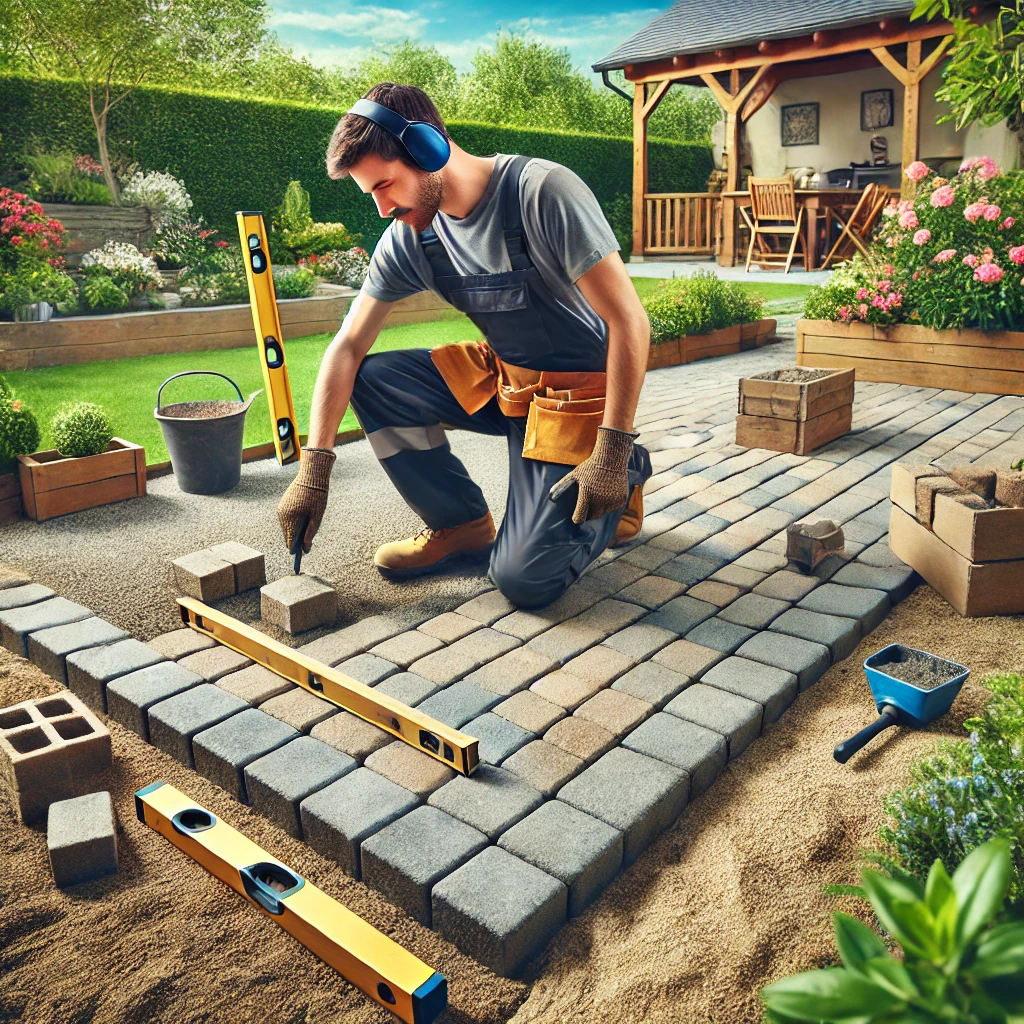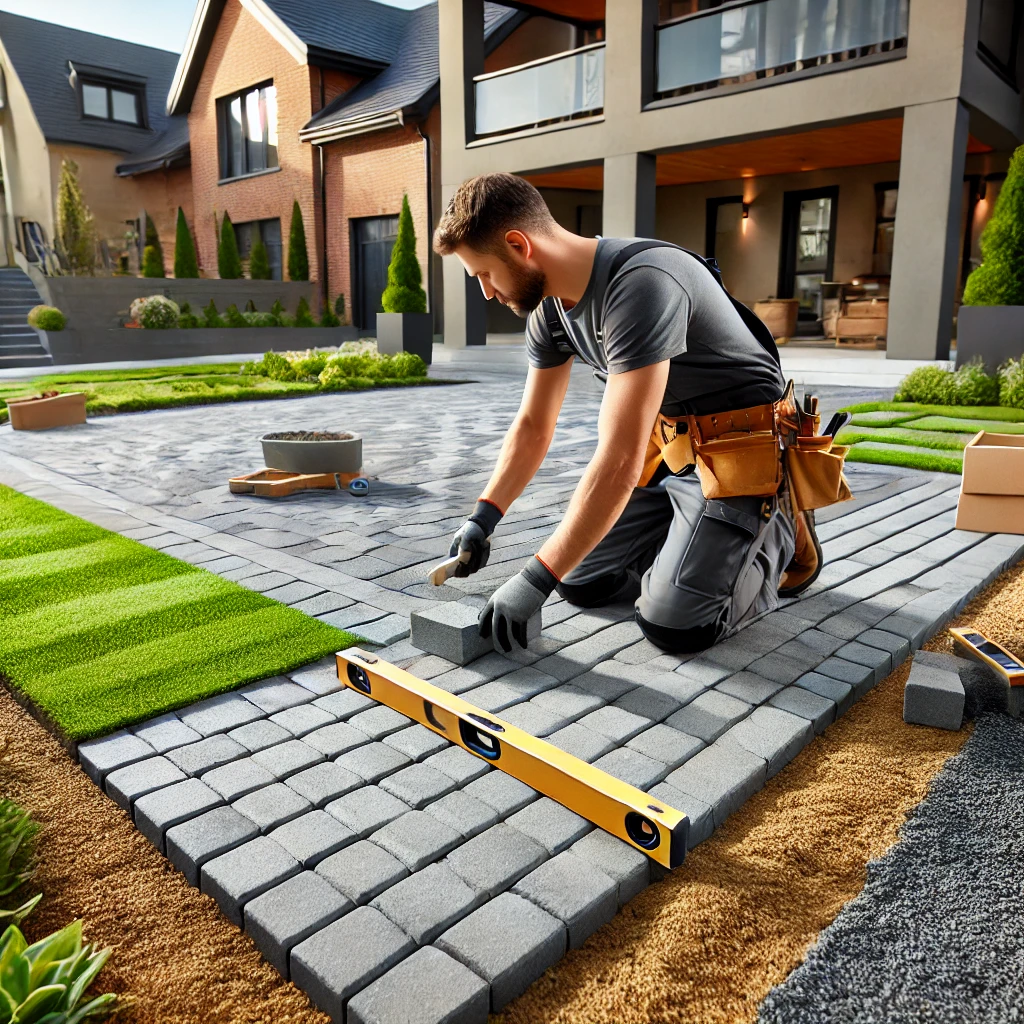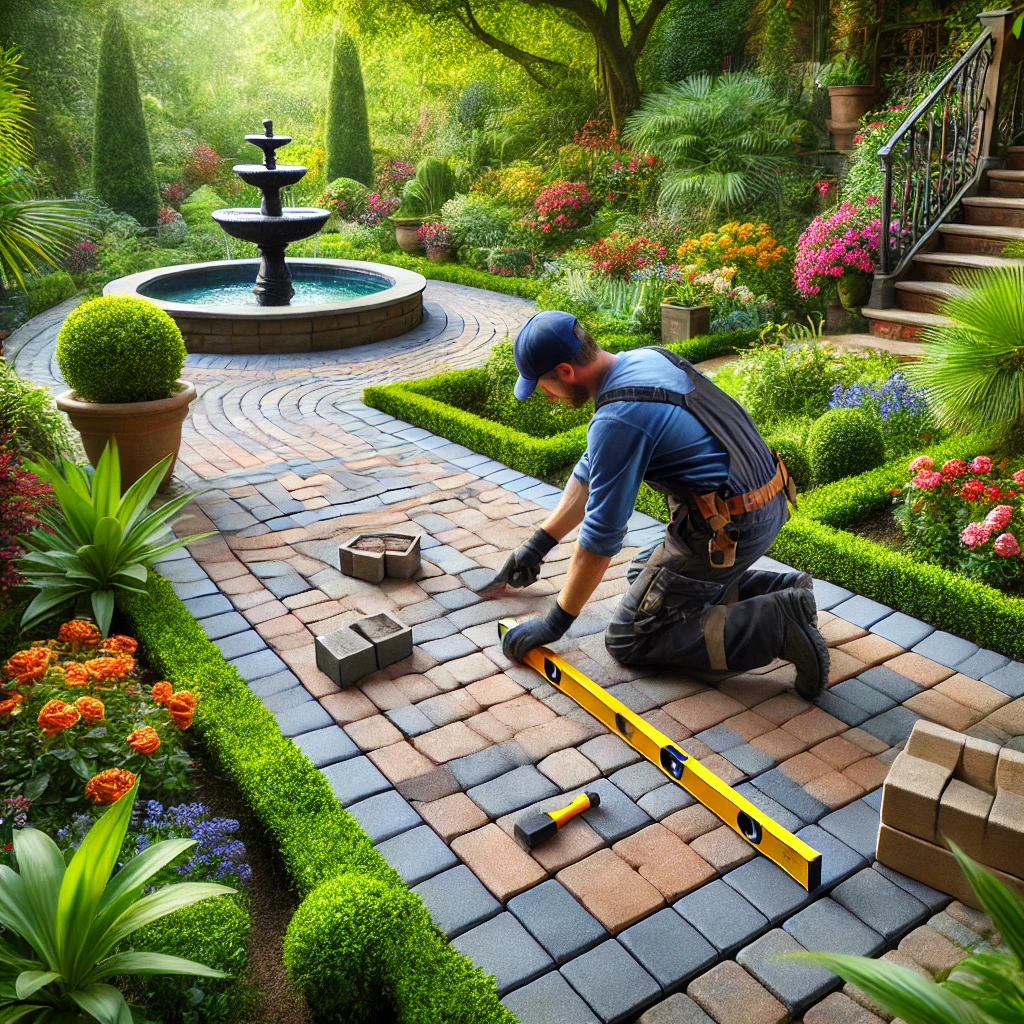Table of Contents
Introduction to Paver Brick Installation
Paver brick installation is a highly sought-after solution for creating durable and visually appealing outdoor surfaces. Known for their versatility, paver bricks are a popular choice for enhancing patios, walkways, driveways, and pool decks. Unlike poured concrete or asphalt, paver bricks are designed to interlock, offering both structural integrity and flexibility. This flexibility allows them to withstand natural ground shifts and temperature changes without cracking, making them ideal for various climates. Their modular nature also means repairs are simple—individual bricks can be replaced without impacting the entire surface. Additionally, the wide variety of colors, shapes, and patterns available ensures that paver bricks can complement any landscape design, offering homeowners and businesses endless creative possibilities.
Beyond aesthetics, paver brick installation provides a long-lasting and practical investment for outdoor spaces. These bricks are made from durable materials like concrete, clay, or natural stone, which can endure heavy foot and vehicle traffic while maintaining their structural integrity. For example, a properly installed paver brick driveway can support the weight of multiple vehicles without damage. Furthermore, the permeable nature of certain paver types helps with water drainage, reducing the risk of pooling and erosion. This makes them an environmentally friendly choice, especially in areas prone to rain. Whether for residential or commercial projects, paver bricks deliver both functionality and style, transforming ordinary spaces into durable and attractive landscapes.
What Are Paver Bricks?
Paver bricks are engineered stones crafted from durable materials such as concrete, clay, or natural stone, making them a reliable option for outdoor construction. Unlike traditional bricks, paver bricks are specifically designed for interlocking, which enhances their strength and stability. This interlocking feature not only prevents shifting over time but also creates a uniform surface capable of withstanding significant weight and pressure. For example, concrete paver bricks are commonly used in driveways because they can support heavy vehicles without cracking. Additionally, clay pavers are prized for their rich, timeless colors that do not fade over time, while natural stone pavers provide a premium, elegant aesthetic perfect for upscale patios or garden paths.
Paver brick installation also offers endless design flexibility, allowing homeowners and businesses to customize their outdoor spaces. The interlocking nature of these bricks makes it possible to create intricate patterns such as herringbone, basketweave, or circular designs, enhancing the visual appeal of any project. Furthermore, paver bricks are available in a variety of sizes, textures, and colors, ensuring they can complement diverse architectural styles. For example, a rustic natural stone paver can match a cottage-style garden, while sleek concrete pavers fit seamlessly into modern landscapes. This versatility and durability make paver bricks a practical and aesthetic choice for transforming outdoor areas.
Benefits of Paver Brick Installation
Paver brick installation offers a host of advantages, making it a favored choice for outdoor renovations. One of the most notable benefits is its durability—paver bricks are designed to withstand heavy foot and vehicle traffic without cracking or degrading over time. Their weather-resistant properties make them ideal for climates with extreme conditions, such as freezing winters or hot summers. For example, unlike poured concrete, paver bricks adapt to ground shifts and temperature changes, reducing the risk of structural damage. Maintenance is minimal, often requiring just occasional cleaning and resealing. This durability and ease of care ensure that paver bricks remain a reliable and long-lasting solution for driveways, patios, and walkways.
Beyond functionality, paver brick installation significantly enhances curb appeal and adds value to properties. The customizable designs allow homeowners and businesses to create unique patterns and layouts, elevating the overall aesthetics of their outdoor spaces. For instance, a beautifully designed paver patio with contrasting brick colors can create an inviting atmosphere perfect for entertaining guests. Additionally, the visual impact of well-maintained paver surfaces can increase property value, attracting potential buyers or clients. With their combination of resilience, style, and return on investment, paver bricks are an excellent choice for upgrading outdoor areas.
Common Applications of Paver Bricks
Paver brick installation is a versatile solution for enhancing various outdoor spaces due to its functionality and durability. Patios are one of the most common applications, where paver bricks provide a stable and attractive surface for outdoor dining and relaxation. Driveways are another popular use, as these bricks can endure the weight of heavy vehicles without cracking, making them a long-lasting alternative to concrete or asphalt. Walkways benefit from the slip-resistant surface of paver bricks, ensuring safety even in wet conditions. For pool decks, their non-slip properties make them ideal, providing both safety and style. Whether in a residential backyard or a commercial courtyard, paver bricks are designed to handle a wide range of applications.
In addition to their functional benefits, paver brick installation allows for creative customization in various settings. For example, walkways can be designed with intricate patterns, such as herringbone or basketweave, to add visual interest and complement surrounding landscapes. In commercial spaces, paver bricks are often used for plazas and courtyards, where their ability to handle heavy pedestrian traffic shines. Pool decks made of paver bricks not only enhance safety but also add a luxurious touch with a variety of colors and textures available. With their adaptability and durability, paver bricks continue to be a preferred choice for both residential and commercial projects.

Planning Your Paver Brick Project
Proper planning is the foundation of a successful paver brick installation. Start by defining the purpose of the area—whether it’s a patio for outdoor gatherings, a driveway for heavy vehicle use, or a walkway connecting garden spaces. The size and shape of the project are critical factors, as they determine the volume of materials needed and influence the overall layout. For instance, a curved walkway might require smaller paver bricks or special cuts to achieve a seamless design. Selecting the right type of paver bricks is equally important. Concrete pavers offer durability and affordability, while clay bricks provide a timeless aesthetic. Consider your budget, but also factor in long-term benefits like reduced maintenance and increased property value.
Another key aspect of planning your paver brick installation is choosing the right pattern and design. Patterns such as herringbone or basketweave not only enhance the visual appeal but also provide added strength, particularly in areas with heavy foot or vehicle traffic. It’s important to take drainage into account during planning to prevent water pooling and potential damage to the installation. Additionally, consulting with a professional can help ensure accurate measurements and efficient material usage. By carefully considering all these elements, you can create a functional and beautiful outdoor space tailored to your needs
Tools and Materials Needed for Installation
A successful paver brick installation begins with assembling the right tools and materials to ensure precision and durability. Key tools include a sturdy shovel for excavation, a tamper to compact the base, and a level to ensure an even surface. A rubber mallet is essential for tapping the paver bricks into place without causing damage. Additional helpful tools may include a measuring tape for accurate layout planning and a masonry saw or chisel for cutting pavers to fit custom designs. Having these tools on hand is critical to achieving a professional-grade result, as improper preparation can lead to uneven surfaces or premature shifting of the bricks over time.
The materials used in paver brick installation are equally important in creating a stable and long-lasting structure. Gravel or crushed stone forms the base layer, providing a strong foundation that prevents settling. A layer of sand is then added on top of the gravel to create a smooth, even surface for laying the paver bricks. The pavers themselves come in various materials like concrete, clay, or natural stone, depending on the desired aesthetic and functionality. Once installed, sand is swept into the joints to lock the bricks in place and prevent movement. This combination of tools and materials ensures a durable and visually appealing outdoor surface.
Preparing the Site
Proper site preparation is a fundamental step in ensuring the durability and longevity of a paver brick installation. The process begins with marking the area to define the project’s boundaries accurately. This step ensures the design aligns with the intended space and minimizes errors during installation. Once the area is marked, all existing vegetation, debris, or old materials must be removed to create a clean workspace. For example, removing grass and roots prevents future plant growth from disrupting the surface. Excavation follows, where the ground is dug to an appropriate depth based on the paver type and intended use. For driveways, deeper excavation is needed to accommodate heavier loads, while patios or walkways may require less depth.
Once the area is excavated, careful attention is needed to create a stable foundation. The depth of excavation should account for the layers of gravel, sand, and the thickness of the paver bricks. A typical paver brick installation requires around 6-8 inches of gravel for driveways and 4-6 inches for walkways or patios. This base layer is compacted with a tamper to eliminate air pockets, ensuring a solid foundation. Slope and drainage are also crucial considerations during site preparation. Grading the area slightly away from structures prevents water from pooling and protects both the paver surface and adjacent buildings. These preparation steps are critical to achieving a professional, long-lasting finish.

Building a Stable Base
A stable base is the foundation of any successful paver brick installation, ensuring durability and preventing future shifting or unevenness. The process begins with laying a layer of compacted gravel or crushed stone, typically 4-8 inches deep, depending on the intended use of the area. For example, a driveway requires a thicker base to support the weight of vehicles, while a patio or walkway may need less depth. Compacting the gravel with a plate compactor eliminates air pockets and creates a solid foundation, crucial for maintaining the structural integrity of the pavers over time. Gravel not only provides stability but also aids in proper drainage, reducing the risk of water damage or frost heave in colder climates.
Once the gravel base is compacted, a layer of sand is added to create a smooth, even surface for the pavers. This sand layer, typically 1-2 inches thick, acts as a leveling bed, ensuring that each paver brick fits snugly and sits evenly. A screed board is used to spread and level the sand with precision, preparing it for the paver placement. Sand also helps absorb minor imperfections in the gravel base and facilitates the interlocking of the bricks during installation. Together, the gravel and sand layers form a stable and resilient base, providing the necessary support for a long-lasting paver brick installation.
Laying the Paver Bricks
The process of laying paver bricks begins with careful planning and precise execution to ensure a professional finish. Start by arranging the paver bricks in the chosen pattern, such as herringbone, basketweave, or running bond, beginning from one corner of the designated area. This systematic approach helps maintain alignment and prevents gaps as you work across the space. A string line or edge restraints can be used to guide placement, ensuring the edges remain straight and uniform. As each brick is laid, use a rubber mallet to gently tap it into the sand base, securing it without causing damage. This step ensures the paver brick installation remains level and tightly interlocked, adding strength and stability.
As you progress, periodically check the level of the paver surface to maintain consistency and avoid uneven areas. Cutting bricks may be necessary to fit the edges or achieve intricate patterns. For this, a masonry saw or brick chisel ensures precise cuts that seamlessly integrate into the design. Once all the bricks are laid, sweep fine sand or polymeric sand into the joints to lock them in place and prevent shifting. This jointing sand also helps resist weed growth and water infiltration, adding to the durability of the surface. With attention to detail, laying the bricks creates the foundation for a visually appealing and long-lasting paver brick installation.
Securing the Installation
Securing the pavers is a critical step in completing a successful paver brick installation, ensuring long-term durability and stability. After all the pavers are laid, fine sand, often polymeric sand, is swept into the joints between the bricks. This sand acts as a binding agent, locking the pavers together and preventing movement caused by foot traffic, vehicles, or natural ground shifts. Polymeric sand, in particular, hardens when activated with water, creating a stronger bond and enhancing resistance to weeds and pests. This step not only stabilizes the surface but also provides a finished, polished look by filling gaps evenly across the installation, ensuring it retains its structural integrity over time.
Proper compaction further secures the paver brick installation and ensures the sand settles deep into the joints. A plate compactor is run over the surface, helping the sand fill every crevice and pushing the pavers firmly into the underlying sand layer. Additional sand may need to be added and swept into the joints to replace any that settles during compaction. This process also prevents water infiltration, reducing the risk of erosion and prolonging the life of the installation. Regularly maintaining the sand-filled joints by replenishing it as needed ensures the paver surface remains stable and visually appealing for years to come.

Maintenance Tips for Paver Bricks
Regular maintenance is essential for preserving the durability and aesthetic appeal of a paver brick installation. Sweeping the surface frequently removes debris, dirt, and leaves that can stain or degrade the pavers over time. Periodic washing with a gentle cleaner and a garden hose or pressure washer helps keep the bricks looking fresh and vibrant. For areas exposed to heavy use or weather extremes, applying a sealant every two to three years can protect the surface from moisture, UV rays, and staining. Sealing also enhances the color of the pavers, ensuring they maintain their visual appeal. Proper maintenance not only extends the lifespan of the paver surface but also prevents small issues from becoming costly repairs.
Despite the durability of paver bricks, occasional damage can occur due to heavy traffic or unforeseen impacts. Fortunately, one of the benefits of a paver brick installation is the ease of repair. Individual damaged bricks can be removed and replaced without disturbing the surrounding area, making it a cost-effective solution compared to concrete or asphalt surfaces. Replenishing joint sand periodically helps prevent shifting and maintains stability. Weed growth can also be managed by using polymeric sand, which hardens in the joints and deters plant intrusion. By following these simple maintenance practices, a paver brick surface can remain strong and visually appealing for decades.
Why Choose Professional Paver Brick Installation?
Opting for professional paver brick installation ensures that your project is completed with the precision and expertise necessary for a long-lasting and visually stunning result. While DIY attempts may seem cost-effective, professionals bring specialized tools, skills, and knowledge to the table. For instance, they know how to properly excavate and grade the site to prevent water drainage issues, which can lead to erosion or pooling if done incorrectly. Additionally, professional installers have experience with various patterns and designs, ensuring a polished finish that enhances the aesthetic value of your outdoor space. By leveraging their expertise, professionals save you the time and effort required for tasks like cutting bricks, compacting layers, and securing pavers, leaving you with a flawless installation.
Hiring experts also guarantees that the paver brick installation will stand the test of time. Professionals understand the importance of building a stable foundation and use high-quality materials to ensure durability under heavy foot or vehicle traffic. They also address potential challenges, such as ground shifting or uneven surfaces, which could compromise the installation if not handled properly. Furthermore, professional installers often provide warranties or guarantees for their work, offering peace of mind and protection for your investment. Whether for a patio, driveway, or walkway, choosing professionals ensures your outdoor project is both functional and aesthetically pleasing for years to come.

